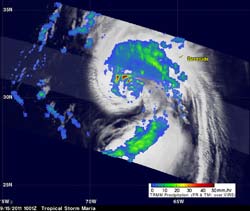NASA's TRMM Satellite Reveals Heaviest Rainfall in Maria's Northwestern Quadrant

NASA's TRMM satellite flew over Tropical Storm Maria on September 15, 2011 at 6:01 a.m. EDT. The heaviest rainfall was occurring in the northwest quadrant of the storm (Red) falling at almost 2 inches (50 mm) per hour. The yellow and green areas indicate moderate rainfall between .78 to 1.57 inches per hour. Credit: SSAI/NASA, Hal Pierce <br>
The Tropical Rainfall Measuring Mission (TRMM) satellite traveled above tropical storm Maria on Thursday, September 15, 2011 at 1001 UTC ( 6:01 a.m. EDT). TRMM has the ability to measure rainfall rates and cloud heights, two factors that are important and helpful to the National Hurricane Center (NHC) meteorologists who are forecasting Maria's next move. The TRMM rainfall data that NASA provides to the NHC is helpful in determining the amount of rainfall that Bermuda will receive as Maria passes by. The NHC forecasts between 1 and 3 inches of rainfall for Bermuda today from Maria.
Maria's organization had improved over that seen by TRMM earlier in the week due to favorable (warmer) sea surface temperatures and lower upper level wind shear. A rainfall analysis from TRMM's Precipitation Radar (PR), displayed in a lighter swath, showed that powerful convective storms were dropping rainfall at a rate of over 50mm/hr (~2 inches) northwest of Maria's center of circulation. A large area of rainfall containing bands of heavier rainfall was also shown by TRMM's Microwave Imager (TMI) to be located between the storm's center and Bermuda. At the time TRMM passed over Maria, the NHC estimated that Maria had wind speeds of 55 knots (65 mph).
At 11 a.m. EDT on Sept. 15, Maria's maximum sustained winds were just shy of hurricane strength at 70 mph (110 kmh) and an eye appeared on microwave satellite imagery. Maria was about 130 miles west of Bermuda near 32.4 North and 67.0 West. Maria was speeding north-northeast at 30 mph (48 kmh) and had a minimum central pressure of 991 millibars. A Hurricane Watch and Tropical Storm Warning are currently in effect for Bermuda as Maria passes by today.
By 2:00 p.m. EDT today as Maria passes to the west of Bermuda, winds are predicted to reach minimal hurricane strength of 65 knots (75 mph). Maria is then forecast to turn to the northeast and speed up.
Text credit: Rob Gutro
, NASA's Goddard Space Flight Center, Greenbelt, Md.
Hal Pierce, SSAI
Media Contact
More Information:
http://www.nasa.govAll latest news from the category: Earth Sciences
Earth Sciences (also referred to as Geosciences), which deals with basic issues surrounding our planet, plays a vital role in the area of energy and raw materials supply.
Earth Sciences comprises subjects such as geology, geography, geological informatics, paleontology, mineralogy, petrography, crystallography, geophysics, geodesy, glaciology, cartography, photogrammetry, meteorology and seismology, early-warning systems, earthquake research and polar research.
Newest articles

Innovative 3D printed scaffolds offer new hope for bone healing
Researchers at the Institute for Bioengineering of Catalonia have developed novel 3D printed PLA-CaP scaffolds that promote blood vessel formation, ensuring better healing and regeneration of bone tissue. Bone is…

The surprising role of gut infection in Alzheimer’s disease
ASU- and Banner Alzheimer’s Institute-led study implicates link between a common virus and the disease, which travels from the gut to the brain and may be a target for antiviral…

Molecular gardening: New enzymes discovered for protein modification pruning
How deubiquitinases USP53 and USP54 cleave long polyubiquitin chains and how the former is linked to liver disease in children. Deubiquitinases (DUBs) are enzymes used by cells to trim protein…



